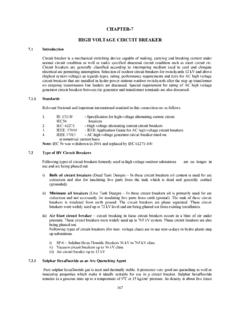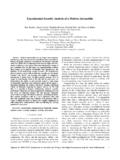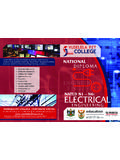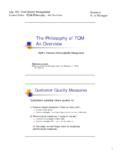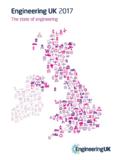Transcription of CHAPTER-5 turbine performance characteristics - …
1 131 chapter -5 turbine performance characteristics (Reviewed by Dr. R. P. Saini, AHEC) turbine performance characteristics turbine performance characteristics of output and efficiency are important parameters. At project feasibility stage these parameters are required to fix number and size of units and determine economic feasibility. For this purpose output and efficiency at part load of the head range for the turbine is required. In tender documents for procurement these characteristics of turbines are specified to be guaranteed under penalty. In evaluation of bids, equalization on accounts of differences in efficiencies of turbines of various bidders is made.
2 Model tests are required to ensure that the guaranteed parameters offered will be met by the proto type. Finally field tests for output and efficiency are conducted at different guide vane/needle openings to determine actual output and efficiency parameters. Penalty for shortfall in efficiency and output and rejection limits are specified. Pr = , hr , Q r , t. r g (kW) Where: Pr = Rated capacity at hr (kW) hr = Selected Design Head (meter) Qr = turbine Discharge at h r Pr (m3/Second) t. r = turbine efficiency at h r Pr (%) g = Generator efficiency , ( %) Figure Francis and Kaplan performance curves (Typical) 132 Pr = , hr , Q r , t.
3 R g (kW) Where: Pr = Rated capacity at hr (kW) hr = Selected Design Head (meter) Qr = turbine Discharge at h r Pr (m3/second) t. r = turbine efficiency at h r Pr (%) g = Generator efficiency , ( %) Figure Propeller turbine performance curves (Typical) turbine performance Curves for Feasibility Studies Figure and figure show typical performance characteristics for Francis, and Kaplan (variable pitch blade propeller with wicket gates). Propeller (fixed blades with wicket gates) and semi Kaplan (variable pitch blades without wicket gates) type turbine . These curves are based on the Feasibility Studies for small scale hydro power Additions Guide manual by US Army Corps of Engineers 1979.
4 These curves were developed from typical performance curves of the turbines of a special speed that was average for the head range considered in the guidelines. Comparisons of performance curves of various specific speed runners were made and the average performance values were used. The maximum error occurs at the lowest Pr and was approximately three percent. These curves may be used to determine the power output of the turbine and generator when the flow rates and heads are known. The curves show percent turbine discharge, percent Qr versus percent generator rating, percent Pr throughout the range of operating heads for the turbine . 133 Following determination of the selected turbine capacity the power output at heads and flows above and below rated head (hr) and flow (Qr) may be determined from the curves as follows: Calculate the rated discharge Qr using the efficiency values- Qr = Pr / ( x hr x x g), (m3/s) Where, Pr, Dr = rated capacity and discharge = turbine efficiency at rated load (%) g = generator efficiency Compute the % discharge, % Qr and find the % Pr on the approximate hr line.
5 Calculate the power output. P = % Pr x Pr (kW) The thick lines at the boarder of the curves represent limits of satisfactory operation within normal industry guarantee standards. The top boundary line represents maximum recommended capacity at rated capacity. The turbine can be operated beyond these gate openings; however, cavitation guarantee generally does not apply these points. The bottom boundary line represents the limit of stable operation. The bottom limits vary with manufacturer. Reaction turbines experience a rough operation somewhere between 20 to 40% of rated discharge with the vibration and/or power surge. It is difficult to predict the magnitude and range of the rough operation as the water passageway configuration of the powerhouse affects this condition.
6 Where operation is required at lower output, strengthening vanes can be placed in the draft tube below the discharge of the runner to minimize the magnitude of the disturbance. These modifications reduce the efficiency at higher loads. The right hand boundary is established from generator guarantees of 115% of rated capacity. The head operation boundaries are typical; however, they do vary with manufacturer. It is seen that these typical performance curves are satisfactory for preliminary feasibility assessments. When the % Qr for a particular selection is beyond the curve boundaries, generation is limited to the maximum % pr for the hr.
7 The excess water must be bypassed. When the % or is below the boundaries, no power can be generated. When the hr is above or below the boundaries, no power can be generated. The optimum number of turbines may be determined by use of these curves for annual power generation. If power is being lost because the % or is consistently below the lower boundaries, the annual energy produced by lowering the kW rating of each unit and adding a unit should be computed. If the total construction cost of the powerhouse is assumed to roughly equal the cost of the turbine and generator, the cost per kWh derived above can be doubled and compared with the financial value of the energy.
8 If the selection of more turbines seems favorable from this calculation, it should be pursued in further detail with more accurate studies. Conversely, the first selection of the number of turbines may be compared with a lesser number of units and compared on a cost per kWh basis as described above. Following the establishment of the numbers of units, the rating point of the turbines can be optimized. This generally is done after an estimate of the total project cost has been made. Annual power production of turbines having a higher rating and a lower rating should be calculated and compared to the annual power production of the turbine selected.
9 With the annual estimate, cost per kWh may be calculated for the selected. With the annual estimate, cost per kWh may be calculated for the selected turbine . Total project cost for the lower and higher capacity ratings may be estimated by adding the turbine /generator costs from the cost chart and correcting the remaining costs on a basis of constant cost per kW capacity. Rates of incremental cost divided by incremental energy generation indicate economic feasibility. The rated head of the turbine can be further refined by optimization in a similar manner. The annual power production is computed for higher and lower heads with the same capacity rating.
10 The rated head yielding the highest annual output should be used. The boundaries established on these curves are typical. Should energy output of a particular site curtailed, it is suggested that turbine manufacturers be consulted as these boundaries can be expanded under certain conditions. turbine performance characteristics Model test Model Testing Model testing has evolved as an essential design element for hydro turbine manufacturers. Most hydro projects specification provide for proof of performance model tests as part of the specifications. Model cavitation testing to determine plant is also carried out. Normally specifications require turbines with already tested model tests to meet the hydraulic design of the offered turbine as regard type, specific speed, rpm submergence and size of the unit.

